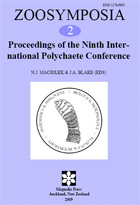Abstract
The ontogeny of parapodia on the first four larval trunk segments was followed toward maturity in the nereidid Laeonereis culveri. The morphologies ultimately attained by the parapodia include cephalic, uniramous, and biramous forms. Setal types and arrangements were also determined for all setigers present on discrete life history stages from larva to adult. The results showed pronounced differences in parapodial morphology and setation between larvae, postlarval juveniles, and adults. These differences stem from the sequential development of parapodial processes and setae. Taxonomists rely heavily on adult setation and parapodial morphology to characterize nereidid species, but since these features vary ontogenetically, their adult states cannot be used to distinguish species during earlier life history phases.

